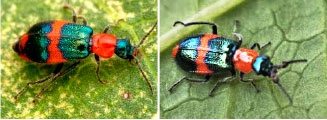A significant but unknown ally in your orchard is the Red and Blue beetle.
For a season that has been very hard on predators and parasitic beneficials, this little fella has come through the hot and dry conditions extremely well, and unnoticed!
In the spring there were substantial green and brown lacewings, and this distinctive Red and Blue beetle (Dicranolaius bellulus).
The hot summer in northern Victoria knocked down the lacewing population, but conditions were conducive for this beneficial ally.
Unfortunate nondescript name
It could have been named the ‘Robin Hood Beetle’, the ‘Red Barron’ or even the ‘Red & Blue Devil’, but it is stuck with the boring, Red and Blue Beetle.
Widespread
The Red and Blue Beetle is a widespread predator in Australian agro-ecosystems. However, very little is known about their biology and their potential as predators of agricultural pests.
They are extremely abundant in a range of habitats in some years, and rare in others.
Tolerates heat & low prey densities
It is an important predator that occurs throughout the summer season.
Their predatory efficacy combined with their ability to tolerate low prey densities when alternative food resources are present, suggests that the Red and Blue Beetle predator can potentially play an important role in pest suppression in Australian crops.
Lifecycle
Adults are found in the crop canopy in the mornings and after sunset.
On hot afternoons they may shelter in bark crevices and sometimes escape insecticide spray.
The beetle lays eggs in clusters on soil debris. The larval and pupal stages occur in the soil, but over-winter as adults.
Rainfall, very high humidity, furrow irrigation and soil cultivation reduce numbers.
Their life cycle generally takes about one year. This is an important IPM point, as any effect (environmental or chemical) on the adult beetle will have long-lasting effects on their population.
Description
Adults are 5 mm long with shiny red and blue metallic coloured bands across the body; and dark head, legs and antennae.
The adults are partly carnivorous and search actively over plants during the day. They eat moth eggs and small larvae and other slow-moving insects.
The eggs, larvae and pupae stages occur in the soil. The larvae feed on small worms and other soil organisms.
For information, see Tree Fruit April 2014




















